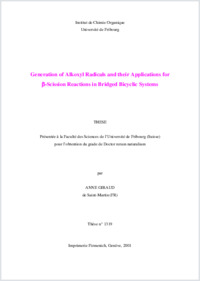Generation of alkoxyl radicals and their applications for ß-scission reactions in bridged bicyclic systems
- Giraud, Anne
- Renaud, Philippe (Degree supervisor)
- Cossy, Janine (Degree supervisor)
-
16.10.2000
138 p
Thèse de doctorat: Université de Fribourg, 2000
English
French
Due to their peculiar reactivity, alkoxyl radicals have unique characteristic properties, which make them powerful tools in modern organic chemistry. Among their typical transformations, β-scission reactions have retained our interest because of their potential in converting stereoselectively bridged bicyclic systems into a variety of useful synthetic intermediates. In this work, we describe our efforts directed toward this goal. We first decided to study a direct method for the generation of alkoxyl radical and treated several norbornenol derivatives with lead tetraacetate. When starting from 2-methylbicyclo[2.2.1]hept-5-en-2-ol, yields up to 65% and total selectivity has been obtained in favor of cis-5-acetylmethyl-2-cyclopentyl acetate. To demonstrate the potential of the developed method for the preparation of versatile cyclopentene synthons, synthesis of a variety of carbanucleoside analogue precursors was achieved from the latter. In a different approach, we developed a new and promising method for the synthesis of medium-sized bridged bicycles with good yields, starting from a readily available norbornenone derivative. The process involves a novel radical intramolecular cyclization/β-fragmentation sequence. Further work led us to take advantage of the radical-induced epoxide fragmentation reaction to generate alkoxyl radicals from oxiranylcarbinyl radicals of bicyclo[2.2.n]alk- 5-ene derivatives. Upon β-scission, cyclization and hydrogen reduction or trapping with an allylstannane, those afforded functionalized bicyclic ketones with moderate to good yields and high stereoselectivities. We then found an application of the well-known sulfoxide-sulfenate rearrangement for the generation of alkoxyl radicals. Indeed, treatment of 2-(1-phenylsulfinylethenyl) bicyclo[2.2.1]hept-5-ene with Bu3SnH/AIBN in refluxing toluene gave 2- vinylbicyclo[2.2.1]hept-5-en-oxyl radical which, after fragmentation, cyclization and trapping, afforded the expected cis-bicyclo[4.3.0]non-7-en-3-one in about 46% yield. Finally, in a preliminary study, we prepared the phenylselenylethanesulfonate derivative from trans-2-phenylcyclohexanol and tested it as an alkoxyl radical precursor. Its reaction with syringe-pump addition of tris(trimethylsilyl)silane and AIBN over 12 h in refluxing toluene, resulted in formation of a 26% yield of trans-2-phenylcyclohexanol, which constituted an encouraging result in favor of a radical pathway for the reaction.
Grâce à leur réactivité particulière et à leurs propriétés caractéristiques, les radicaux alkoxyles constituent un outil puissant de la chimie organique moderne. Parmi leurs transformations typiques, les réactions de β-scission ont retenu notre attention. En effet, la conversion stéréoselective de systèmes bicycliques pontés, permet d’obtenir de nombreux intermédiaires synthétiques utiles. Dans ce travail de thèse, nous décrivons nos efforts à ces fins. Etudiant dans un premier temps les méthodes directes de génération des radicaux alkoxyles, nous avons traité des dérivés du norbornènol avec du tétraacétate de plomb. Dans ces conditions, le 2-méthylbicyclo[2.2.1]hept-5-èn-2-ol produit le cis-5- acétylméthyl-2-cyclopentyl acétate, avec un rendement de 65% et une stéréosélectivité totale. Afin de démontrer le potentiel de cette méthode pour la préparation de synthons cyclopentènes, nous avons synthétisé plusieurs précurseurs d’analogues de carbanucléosides. Nous avons ensuite développé une nouvelle voie de synthèse des bicycles pontés de taille moyenne, en partant d’un dérivé de la norbornanone très facilement accessible. Le processus implique une séquence de cyclisation radicalaire intramoléculaire/β-fragmentation originale. La réaction de fragmentation d’époxyde induite par un radical nous a permis de générer des radicaux alkoxyles à partir de radicaux oxiranylcarbinyles dérivés de bicyclo[2.2.n]alk-5-ènes. Leur β-scission/cyclisation suivie d’une réduction par un atome d’hydrogène ou d’un piégeage avec un allylstannane, a donné des cétones bicycliques fonctionnalisées avec des stéréoselectivités élevées. Nous avons appliqué le réarrangement sulfoxyde-sulfénate à la génération de radicaux alkoxyles. En effet, le traitement du 2-(1-phénylsulfinyléthènyl)bicyclo[2.2.1]hept-5-ène avec Bu3SnH/AIBN dans le toluène à reflux a fournit le radical 2- vinylbicyclo[2.2.1]hept-5-èn-oxyle qui, après fragmentation, cyclisation et piégeage a conduit à la cis-bicyclo[4.3.0]non-7-èn-3-one avec un rendement de 46%. Enfin, nous avons développé une voie originale, donnant accès à un nouveau précurseur de radicaux alkoxyles. La réaction du dérivé phénylsélényléthanesulfonate du trans-2-phénylcyclohexanol en présence de tris(triméthylsilyl)silane et d’AIBN additionnés au pousse-seringue en 12 h, a produit le trans-2-phénylcyclohexanol avec un rendement de 26%, ce qui constitue un résultat encourageant en faveur d’un mécanisme radicalaire de la réaction.
- Faculty
- Faculté des sciences et de médecine
- Department
- Département de Chimie
- Language
-
- English
- Classification
- Chemistry
- License
-
License undefined
- Identifiers
-
- RERO DOC 5328
- URN urn:nbn:ch:rero-002-101622
- RERO R003016745
- Persistent URL
- https://folia.unifr.ch/unifr/documents/299940
Statistics
Document views: 530
File downloads:
- Texte intégral: 3623
